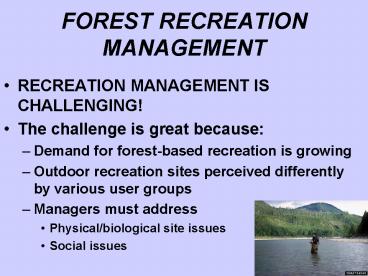FOREST RECREATION MANAGEMENT - PowerPoint PPT Presentation
1 / 19
Title:
FOREST RECREATION MANAGEMENT
Description:
Demand for forest-based recreation is growing ... Occurs during leisure time. RECREATION MANAGEMENT ENVIRONMENT. Recreation is a highly visible forest use ... – PowerPoint PPT presentation
Number of Views:1071
Avg rating:3.0/5.0
Title: FOREST RECREATION MANAGEMENT
1
FOREST RECREATION MANAGEMENT
- RECREATION MANAGEMENT IS CHALLENGING!
- The challenge is great because
- Demand for forest-based recreation is growing
- Outdoor recreation sites perceived differently by
various user groups - Managers must address
- Physical/biological site issues
- Social issues
2
OUR TOPICS
- What is Recreation?
- Priorities
- Planning
- A Few Closing Points
3
RECREATION DIFFERS FROM OTHER BEHAVIORS
- Characteristics of recreation
- Requires commitment by recreationist
- Self-rewarding i.e. pleasant in and of itself
- Requires personal and free choice
- Occurs during leisure time
4
RECREATION MANAGEMENT ENVIRONMENT
- Recreation is a highly visible forest use
- Many people relate easily to forest recreation
(and have strong opinions!) - Yet management of forest recreation
- Less understood historically than that of other
forest resources - Historically a reaction to
- problems (i.e. unplanned)
5
FOREST RECREATION COMPONENTS
- Components of forest recreation include
- 1. Resource base
- 2. Visitors (users)
- 3. Development of site facilities
- To permit recreational use
- To enhance recreational use
6
FOREST RECREATIONWhat is the product?
- Recreation Product ? User Satisfaction
- Product is produced by user
- Recreation manager
- Provides recreation opportunity
- Does not provide the product
7
FOREST RECREATION MANAGEMENT PRIORITIES
- High priorities
- Dissemination of information, e.g.
- Environmental interpretation
- Visitor safety advice
- Indirect management of visitors
- Low priorities
- Resource manipulation
- Visitor manipulation
- Enforcement (except in heavy-use areas)
8
FOREST RECREATION MANAGEMENT PLANNING
- DEFINITION
- Planning ? process that zones space based on
program objectives (i.e. type and level of use
desired) - Planning necessary prior to
- Development of access transportation system
- Development of site facilities
9
FOREST RECREATION MANAGEMENT PLANNING
- Trade-offs are often necessary, e.g.
- Timber extraction vs. recreation
- Developed recreation vs. wilderness recreation
- Functional compatibility sometimes possible
- E.g., hiking timber management if hiking trails
are located appropriately
10
FOREST RECREATION MANAGEMENT PLANNING
- Users have variety of desires
- Recreation managers must accommodate this variety
- Recreation Opportunity Spectrum (ROS) see
Figs. 17.2 17.3 - Visitor Norms vary across the ROS
11
FOREST RECREATION MANAGEMENT PLANNING
See Fig. 17.2 in your text (Recreation
Opportunity Spectrum) Visitor Norms vary
across the ROS
12
FOREST RECREATION MANAGEMENT PLANNING
- Recreation opportunities are provided by a
combination of - Management by Objectives
- (planning phase establishes goals)
- Management by Design
- (implementation phase)
13
RECREATION PLANNINGMANAGEMENT BY OBJECTIVES
- Establishes program goals objectives
- Inputs include
- Resource capability (imposes limitations)
- Institutional constraints (may reduce options)
- Existing situation (may dictate initial plan)
- User preferences (IMPORTANT)
- Coordination (if gt 1 landowner)
- Output
- Recreation program objectives
14
RECREATION PLANNING RESOURCE CAPABILITY
- Carrying Capacity
- Sustained level of use without degrading
- Physical environment
- Visitor experience
- Easily measured in some situations, e.g.
- Campgrounds
- Picnic sites
- Not easy to measure in, e.g., wilderness
- Important factor because
- Demand often gt carrying capacity
- Sites deteriorating in some areas
15
RECREATION PLANNINGMANAGEMENT BY DESIGN
- Implementation phase
- Zoning site design are used to achieve the
objectives - For example, a good campground design
- Emphasizes aesthetics informal socialization
- Subtly directs where to pitch tent, park car,
etc. - Tends to attract a particular
- visitor norm
- Needs little direct management
16
RECREATION PLANNERS MUST BE FLEXIBLE!
- Social Succession
- Displacement of one user group by another
- Often due to failure to follow original plan
(e.g., small changes in development -- widening a
road, installing a footbridge . . .) - Negative for some, beneficial for others
- May lead to conflict
17
FOREST RECREATION MANAGEMENT PLANNING
- Managers seek to maximize benefit to users (not
to managers!)
18
RECREATION MANAGEMENTA FEW CLOSING POINTS
- Decisions often controversial, especially in
wilderness or areas heavily used by several
visitor norms - If goal is status quo, planning is necessary
- If goal is change, planning is necessary
- Failure to plan is a decision (with
consequences!) - Management requires not only planning, but also
implementation
19
RECREATION MANAGEMENTA FEW CLOSING POINTS
- Recreation management plans never final
- Managers must be responsive to changing
conditions public pressures































